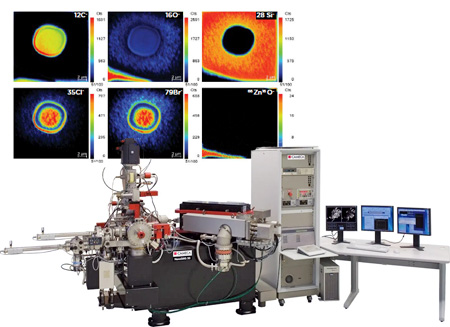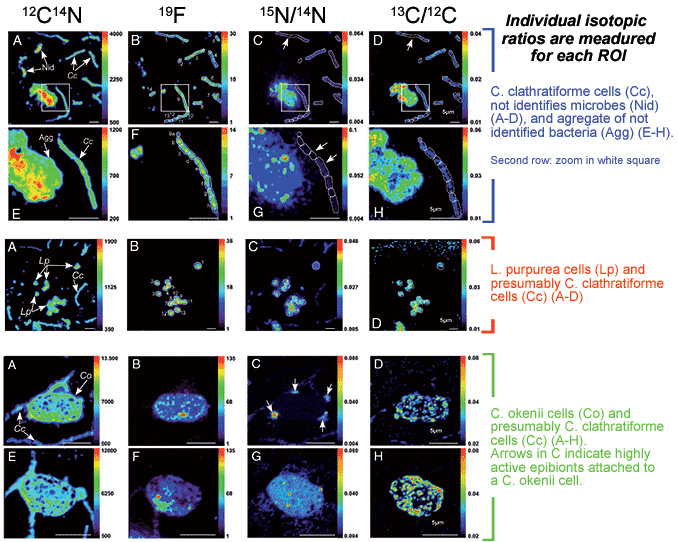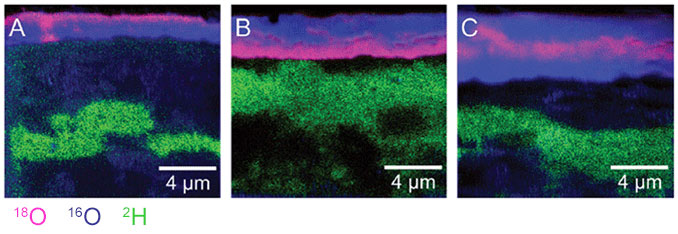CAMECA NanoSIMS 50L
SIMS microprobe for ultra-fine feature analysis
The CAMECA NanoSIMS 50L is a unique ion microprobe for isotopic and trace element analysis at high spatial resolution.
- High spatial resolution (down to 50 nanometers).
- High sensitivity (ppm in element imaging).
- High mass resolution (M/dM).
- Parallel acquisition of seven masses.
- Fast acquisition (DC mode, not pulsed).
- Analyse electrically insulating samples.
- Isotope ratio reproducibility of a few tenths of permil.
Contact us for more information and quotes:
+44 (0)1223 422 269 or info@blue-scientific.com

Application Areas
Microbiology
- Quantitative measurement of metabolic activity of single microbial cells in environmental samples.
- Metabolic activity of individual cells and phylogenetic identity with ISH.
- In situ studies of uncultivated or rare microbial cells in complex ecosystems.
- Study symbioses and microbial interactions.
Brochure from CAMECA: SIMS in Environmental Microbiology
Left: Ecophysiology of anaerobic phototrophic bacteria (click to enlarge). From: A single cell view on the ecophysiology of anaerobic phototrophic bacteria. N. Musat et al., PNAS, Nov. 18, 2008, vol. 105, no. 46.
Cell Biology
- Molecule and trace element imaging at sub-cellular resolution.
- Micro-organisms to human cells.
- 2D and 3D imaging with 50nm resolution.
- Detect stable isotopes and trace element tagged molecules, and analyse their distribution.
- Measure kinetics and fluxes.
Brochure from CAMECA: SIMS in Cell Biology
Image from: Multi-isotope imaging mass spectrometry quantifies stem cell division and metabolism. Matthew L. Steinhauser, Andrew P. Bailey, Samuel E. Senyo, Christelle Guillermier, Todd S. Perlstein, Alex P. Gould, Richard T. Lee & Claude P. Lechene. NATURE, vol 481, 26 January 2012
Geology and Space Science
- Measure isotopes and trace elements of deep sub-micron areas, grains or inclusions from interplanetary dust particles, meteorites, and mineral sections.
- Precise isotope ratio measurements (with spot size of a few µm) and external reproducibility down to a few tenths of permil.
- 50nm spatial resolution for sharp chemical and isotopic imaging.
- Parallel collection of up to 7 species for simultaneous isotopic and/or elemental analysis.
Brochure from CAMECA: SIMS in Materials and Geosciences
Left: Analysis of extracellular biomineralisation in biogeochemistry. From: John W. Moreau, P.K. Weber, M.C. Martin, B. Gilbert, I.D. Hutcheon, J.F. Banfield, SCIENCE, vol 316, 15 June 2007.
Materials Research
- High sensitivity at high mass resolution with no mass interference.
- Trace element (dopant) imaging and quantification with 50nm SIMS lateral resolution.
- Suitable for electrically insulating materials.
- Analyse all elements from hydrogen to plutonium, except noble gases.
Brochure from CAMECA: SIMS in Materials Science
Image from: An investigation of the oxidation behaviour of zirconium alloys using isotopic tracers and high resolution SIMS. Sean S. Yardley, Katie L. Moore, Na Ni Jang Fei Wei, Stuart Lyon, Michael Preuss, Sergio Lozano-Perez, Chris R.M. Grovenor. Journal of Nuclear Materials 443 (2013) 436–443.





